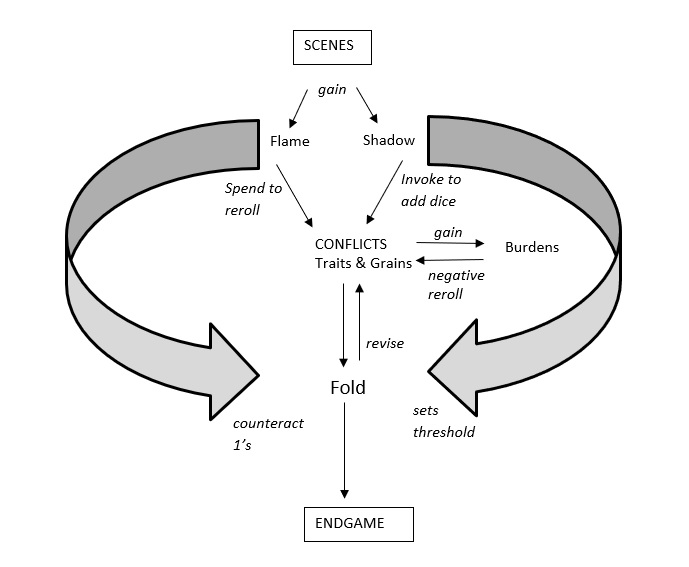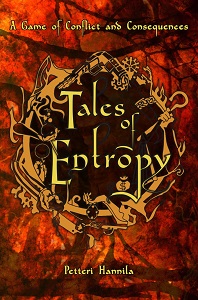I’ve stitched together two consulting sessions with Petteri Hannila, the author of Tales of Entropy. The first part is audio only, but please view rather than listen, because I’ve filled it all with visual content. I’m beginning to make these sessions work both privately and publicly.
This client is a little different because the game is already published: here’s the RPGNow link and it’s also on DriveThru, Amazon, et cetera. Petteri’s main concern is promotion and publication strategy, but he’s open to rewriting as part of that, so we spend most of our time on the design, as our way to get to the main question.
The “guts” of the game are sound, or as much as I can tell prior to our upcoming play session, which will appear here in Actual Play. I strongly criticized the presentation which emphasized its group-setup and trading-off qualities to the extent of devaluing its consequential, driving play-features. I also raised the question of open-setting, do-anything as an attractive vs. attention-deadening feature.
All thoughts, inquiries, and comparisons are welcome!



4 responses to “To get a diamond, you crush the coal”
Thanks So Much For Posting This!
I purchased Tales of Entropy right when it came out and I’m really looking forward to playing it, hopefully very soon! From everything I know and have heard from folks I trust and respect, it sounds like it will be exceptional! I would be very excited for any additional supplementary material you publish for ToE, especially, if it is in book form.
It really is a balancing act, in these type of games, to determine just how much exposition one should cover during the setup stage. It is a fine line between getting everyone on the same page and committed to the same tone, etc. while still doing so in an elegant matter that leaves room for an open-ended story, which can go in a lot of different and unexpected places.
Let’s face it, playing many of the GMless games in this design space can be like wrangling cats, and it is a challenge to know just the amount and type of upfront scaffolding is desirable. This discussion made me think about how my own game may be overly designed and front-loaded in this manner.
As I see it, the biggest danger in these type of games is the gonzo factor in which a story with a more serious tone gets whimsical and silly, which is why there is a necessity to get everyone on the same page during setup—or some other way at the beginning of play—but to do so in the most elegant yet beneficial fashion possible.
In addition to pointing out the issues above, Ron, also pointed out the “let’s just all get along” ideal that is common in this design space, and assumes that so-called “niceness” is the ultimate virtue, can be a major issue. I’ve also experienced this problem undermining play: an individual can essentially undermine the groups’ play experience if “niceness” is the central tenet, because no individual contribution can be questioned, no matter how absurd or contradictory to the narrative, after all, it wouldn’t be nice to do so. I feel that this approach suffers from idealism, and at least in my sessions hasn’t been productive. It can lead to an incoherent tone and the silliness factor that Ron mentioned.
Telling a good and satisfying story is one of the main things that is appealing to those who most enjoy these types of games, and is also one of the main aims of them. The rate of unsatisfactory stories in sessions of these type of games, is the number one complaint players have commented to me about. If you let one person undermine a good, satisfying story at the cost of the whole groups’ enjoyment, have you really respected each individual’s creative contribution at the table, which was your design aim in the first place? Or have you sacrificed the needs of a group of many individuals’ creative contributions for a single individuals?
Rules and procedures can be designed that successfully address this issue while not creating feelings of ill-will between the players, and which do not shut down creative contributions or simple esthetic difference. The important thing is to limit the types of contributions that can be used to “adjust” a narrative contribution and to apply this technique rarely, only when absolutely necessary.
In my own game, one may only suggest an “adjustment” to a narrative contribution if it fits one of the following criteria.
1. The contribution significantly clashes with the agreed upon tone of the story—my game is inspired by Game of Thrones so this helps to get players on the same page in regards to expectations, and the specific aspects of the tone are also defined and agreed upon prior to play.
2. The contribution significantly undermines the the believability of the story—for example, by introducing something absurd, silly, unreasonably improbable, incoherent within the larger context of the fiction (like contradicting established facts, etc)— in essence, by introducing something that significantly undermines the verisimilitude of the story. If one of the contributions fits the above criteria, then a player may say, “What About?…” and then make a suggestion to modify another’s contribution; however, the player doing so must suggest a narrative contribution themselves in place of the original contribution, not simply object to the original contribution, and the suggested change should keep to the creative “spirt” of the fist contribution intact as is reasonably possible. It is also understood that this “adjustment” isn't based on the first contributor having done anything wrong; rather, it is simply to help make sure that everyone enjoys the story. It also isn’t to be abused or used in excess. And players should be especially careful about using it with new players: you don’t want a new player to think that they are “bad” at roleplaying and scare them off before they’ve even had an opportunity to give it a chance.
With friends, using the “What About?…” mechanic isn’t as necessary, but often strangers are hesitant to communicate even the smallest differences; instead, walking-on egg shells with one another, and overtime people can feel as though the story is regularly being spoiled and ill-feelings can develop.
These are the types of games I play. I play a different one about every week to try to get better at design, so I’ve seen many of the issues Ron raises manifest themselves at the table, and can speak to the fact that these are definitely big issues in this design space. I especially think that the “lets just be nice” factor, and the “silliness,” “improbableness” and “unbelievability” factors that undermine verisimilitude and a constant tone, are very central issues/problems that often pop up.
I’m planning to have Ron consult on my game (if he agrees to), which is also a “collaborative storytelling game”— for lack of a better term—and I’m excited about his feedback regarding the design, and possibly, the marketing of the game.
Thanks guys, I really enjoyed the video, and would love to see any future consulting videos about ToE or other games of this type!
Hi Jeff, thanks for the kind
Hi Jeff, thanks for the kind words for both the game and the video. Considerable credit goes to Petteri who has a dislocated shoulder and carried on with resolve. (really, I felt bad while editing the video and seeing him power through it)
That makes four games of this sort, each with its own distinct angles and solutions, that I’m consulting for right now! Tales of Entropy, Directions Storyplaying, Be-Movie, and House of Spiders.
I’m seeing over and over again that all this careful massaging for set-up, what amounts to corporate-level management meeting, is a good case of the cure being worse than the disease. It doesn’t prevent the greatly-feared silliness and even, frankly, invites it, and once that sets in, the compensating mechanisms make it still worse.
In other words, they do not work. I can’t think of a better indictment of what twenty-five years of effort have failed to achieve.
I feel like the guys in the film Office Space, when one of them grumbles that his super-awesome program technically worked: they shout at him, “It did not work, Michael!!”
The whole thing needs re-thinking. We need to recognize Theatrix and Millinger’s essay as what they were, ideas and attempts, not a “school” based on successful play. Design work of this type should begin with ceasing to try to be a type, and to concentrate on its own successful experiences.
For example:
One element I spotted in your comment was the distinction between playing with friends vs. playing with … something else. This bears further discussion relative to to my recent GDR Unplugged interview and with another consult I’m doing right now, regarding cold play with strangers, for a single session, and how that does and does not work for playtesting. So that topic will be developed here in detail.
Thanks again, Jeff. I’m looking forward to working with you and also to your comments across the other games that will show up soon here in Consulting.
Squinting my eyes
Hi Ron,
What does the text say at https://youtu.be/8pjvw2ps0UM?t=1604? (26:44)
“Here’s a glimpse of the
"Here's a glimpse of the mechanics, very surprising, full of consequence"
Sorry about that. I enlarged the diagram at some point during editing and didn't check back to see what happened to text that fit before I did it.